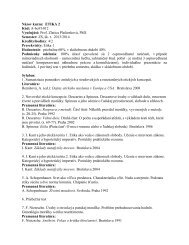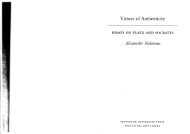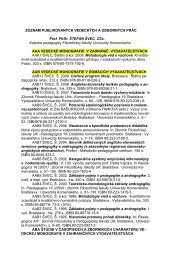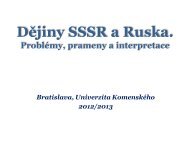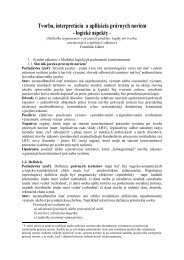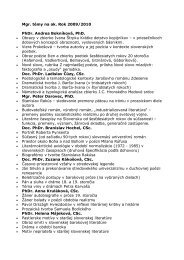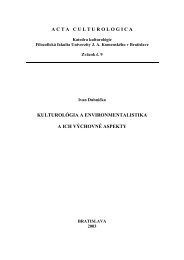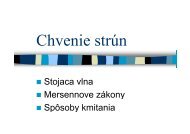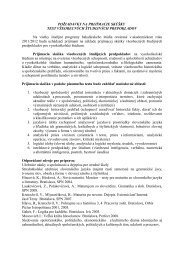Cumans and Kipchaks: Between Ethnonym and Toponym
Cumans and Kipchaks: Between Ethnonym and Toponym
Cumans and Kipchaks: Between Ethnonym and Toponym
Create successful ePaper yourself
Turn your PDF publications into a flip-book with our unique Google optimized e-Paper software.
ZBORNÍK FILOZOFICKEJ FAKULTY UNIVERZITY KOMENSKÉHO<br />
ROČNÍK XXXIII – XXXIV GRAECOLATINA ET ORIENTALIA BRATISLAVA 2012<br />
¯¯¯¯¯¯¯¯¯¯¯¯¯¯¯¯¯¯¯¯¯¯¯¯¯¯¯¯¯¯¯¯¯¯¯¯¯¯¯¯¯¯¯¯¯¯¯¯¯¯¯¯¯¯¯¯¯¯¯<br />
<strong>Cumans</strong> <strong>and</strong> <strong>Kipchaks</strong>: <strong>Between</strong> <strong>Ethnonym</strong> <strong>and</strong> <strong>Toponym</strong><br />
Jaroslav DROBNÝ, Bratislava<br />
In the Middle Ages, Central Europe was exposed to several waves of<br />
nomadic raids from the East, frequently also connected with the resettlement of<br />
certain nomadic ethnic groups (Huns, Avars, Magyars <strong>and</strong> Pechenegs) in a new<br />
territory. The penultimate <strong>and</strong> to a large extent also the final waves were<br />
associated with the <strong>Cumans</strong>, a people of Turkic origin.<br />
The <strong>Cumans</strong> were the last of the steppe nations who came from Central<br />
Asia before the Mongolian invasion. They spoke the Turkic language, yet it<br />
seems that many of them were blond with blue eyes 1 . We can include their<br />
journey westwards, which came about for various specific reasons (<strong>and</strong> how<br />
specifically their arrival showed itself in Hungary), with the same wave of<br />
nomadic raids of Central Europe which started with the Old Hungarian tribes.<br />
The Pechenegs, Oghuzs <strong>and</strong> <strong>Cumans</strong> followed the same route, but Hungary<br />
was already a barrier between them <strong>and</strong> Latin Europe 2 .<br />
In the 10 th century, these people were brought to the notice of historians <strong>and</strong><br />
geographers. At that time they resided in the north-east of what is today’s<br />
Kazakhstan, to the east of the Khazars, to the north of their relatives the<br />
Oghuzs, <strong>and</strong> to the east of another related ethnic group, the Kimaks. They were<br />
divided into several tribes, which were often nothing more than bigger clans. In<br />
the mid-10 th century, the <strong>Kipchaks</strong> followed the Oghuzs, crossed the Volga<br />
River <strong>and</strong> “flooded” the steppes to the north of the Black Sea <strong>and</strong> the Caucasus<br />
Mountains. They gave their name to this territory, which in medieval European<br />
————–———–——<br />
1 MUSSET, Les invasions : le second assaut contre l’Europe chrétienne, p. 79.<br />
2 Ibid., p. 59.<br />
205
sources was called Cumania, the l<strong>and</strong> of the <strong>Cumans</strong>; for the Russians it was<br />
known as the Polovetsian Steppe, <strong>and</strong> for the Arabs <strong>and</strong> Persians it was the<br />
Kipchak Desert. A reflection of this toponym has been probably preserved<br />
today in the name referring to the steppes to the north of the Caucasus Mountains,<br />
Kuban.<br />
The first empire was born in the Kipchak steppes when the successors of<br />
Genghis Khan shared <strong>and</strong> divided the Mongol Empire among themselves.<br />
Therefore, the empire is better known as the “Golden Horde”.<br />
Among other things, this ethnic group is interesting due to the fact that we<br />
have accounts of it from several “civilizational domains”. Western European,<br />
Russian <strong>and</strong> Byzantine chroniclers as well as Arabic <strong>and</strong> Persian annalists<br />
wrote about them.<br />
To their contemporaries, they were known by various names. The Russians<br />
knew them as the Polovtsi, Latin <strong>and</strong> Greek Europe as <strong>Cumans</strong>, <strong>and</strong> Persia <strong>and</strong><br />
the Arabic East knew them as the <strong>Kipchaks</strong>. The three names were three designations<br />
for one people. Moreover, one needs to add different variations of<br />
these three names 3 , which are more than enough for one people.<br />
However, another interesting fact is that very few sources acknowledge the<br />
unity or at least the kinship of these three names, which all refer to one ethnic<br />
group. This becomes especially conspicuous in ancient texts, which use two<br />
traditional names for this ethnic group without realizing that the two refer to<br />
the same people.<br />
Almost univocally (virtually with only one exception), European authors<br />
never used the name Kipchak with regard to this ethnic group. This tempted the<br />
conclusion that the texts do not refer to the same ethnic group but rather to two<br />
or even three different groups: namely the <strong>Cumans</strong> in the west between the<br />
Dnieper River <strong>and</strong> the Carpathian Mountains (later on even as far as the<br />
Danube River), the Polovetsians between the Dnieper <strong>and</strong> Volga Rivers, <strong>and</strong><br />
the <strong>Kipchaks</strong> between the Volga <strong>and</strong> Irtysh Rivers.<br />
The Kipchak confederation, containing Turkic, Mongolic, <strong>and</strong> Iranian elements,<br />
comprised three large sub-confederations: the Cuman union in the west,<br />
divided into Ural-Volga, North Caucasian, <strong>and</strong> Pontic-Danubian groups; the<br />
<strong>Kipchaks</strong> in Central Asia <strong>and</strong> Kazakhstan; <strong>and</strong> the West Siberian <strong>Kipchaks</strong> 4 .<br />
————–———–——<br />
3 The Medieval world knew them by different names: Polovetsy, Polovtsy (rus.), Kunok<br />
(hung.), Qipchaq, Kipchak, Qifjaq, (arab. <strong>and</strong> pers.), Falven (ger.), Cumani, Comani (latin).<br />
The Anglicized forms for this nation (or nations) are Kipchak <strong>and</strong> Cuman.<br />
4 AHINZHANOV, Kipchaki v istorii srednevekovo Kazakhstana, pp. 195 – 197.<br />
206
Regional groupings, such as the Ural-Volga-Don-centered “Wild <strong>Cumans</strong>”<br />
(Polovtsi Dikii in Russian sources), were involved in Rus internecine strife 5 .<br />
Despite marital ties with the ruling houses of Rus’, Georgia, Khwarizm <strong>and</strong><br />
later Hungary, the <strong>Kipchaks</strong> were often fickle allies.<br />
However, the question is: When is the ethnonym <strong>and</strong> when is the toponym?<br />
In the sections of their compositions devoted to peoples who lived far from<br />
the Caliphate Eastern European <strong>and</strong> Asian steppes, Arabian <strong>and</strong> Persian geographers,<br />
travelers <strong>and</strong> historians of the 9 th – 10 th centuries were continuously<br />
mentioning the people <strong>and</strong> the country of the Kimaks. The first to name the<br />
Kimaks (<strong>and</strong> their branch the <strong>Kipchaks</strong>) in the list of Türkic tribes was the<br />
well-known Arabian geographer Ibn KhurdAdbih in the Book of Roads <strong>and</strong><br />
Kingdoms (second half of the 9 th century), who in his work used earlier compositions<br />
(possibly even from the 8 th century) 6 . Probably this is the first mention<br />
of the <strong>Kipchaks</strong> in Arab sources 7 .<br />
ﺮﻐﺠﻟاو ﺰﻐﻟاو كﺎﻤﻴﻜﻟاو ﺦُﻟﺮﺨﻟاو ﺖﺒّﺘﻟاو ﻦﻴﺼﻟا<br />
ﻢهّﺪﺣ كﺮﺘﻟا دﻼﺑ ﻊﺳوأ ﻢهﺪﻠﺑو ﺰﻏﺰﻐﺘﻟا كاﺮﺗﻷا ناﺪﻠﺑو<br />
ﻦﻣ ﺐﻧﺎﺠﻟا اﺬه ﻦﻣ ﻲهو ﺞﻠﺨﻟاو ﺦﻟﺮﺨﻟاو ﻚﺴﻣ ﺎﻬﺑو ﺰﻴﺧﺮِﺧو خﺎﺸﻔِﺧو ﺶآذأو ﺶآﺮﺘﻟاو كﺎﻧﺎﺠﺒﻟاو<br />
ﺮﻬﻨﻟا<br />
The l<strong>and</strong> of the Turks Toquz Oghuz (al-AtrAk at-TaGazGaz) is the most extensive<br />
of the Turkic countries. They border with China <strong>and</strong> Tibet (at-Tubbat)<br />
<strong>and</strong> the Karluks (al-Kharlukh), Kimaks (al-KimAk), Oghuzs (al-Guzz), Chigils<br />
(al-ÖiGir), Pechenegs (al-Baöānāk), Turgesh (at-Turkash), Edhgishs (Aükish),<br />
<strong>Kipchaks</strong> (Khifshākh) <strong>and</strong> Kirghizes (Khirkkhīz), who have musk, Karluks (al-<br />
Kharlukh), <strong>and</strong> Khalajis (al-Khalaö). They are on this side of the river 8 .<br />
For comparison, here is the text from YaqUt’s The Dictionary of Countries 9 :<br />
ﻞﻀﻔﻳ مﺪﻗ ﺮﺸﻋ سﺪﺳو رﺎﺸﻋأ ﺔﺘﺳو ماﺪﻗأ ﺔﻌﺒﺳ ءاﻮﺘﺳﻻا ﻲﻓ رﺎﻬﻨﻟا ﻒﺼﻧ ﻞﻈﻟا نﻮﻜﻳ ﺚﻴﺣ ﻪﻟوأ<br />
كﺎﻤﻴآو ﺰﻴﺧﺮﺧو نﻮﻗو ﻰﻧﺎﻗ ﻦﻣ قﺮﺸﻤﻟا كﺮﺗ ﻦآﺎﺴﻣ ﻦﻣ ءىﺪﺘﺒﻳ ﻂﻘﻓ ﺪﺣاو<br />
مﺪﻘﺑ ﻪﻟوأ ﻰﻠﻋ ﻩﺮﺧﺁ<br />
رﺰﺨﻟا دﻼﺑو بارﺎﻓو ﺔﻴﻧﺎﻤآﺮﺘﻟا ضرأو ﺰﻏﺰﻐﺘﻟاو<br />
————–———–——<br />
5 GOLDEN, The Polovci Dikii, p. 298.<br />
6 PLETNEVA, Polovtsi, p. 31.<br />
7 IBN KHURDĀDBIH, KitAb al-masAlik wa al-mamAlik, p. 31.<br />
8 Syrdarya.<br />
9 YĀQŪT, Mucöam al-buldAn I., p. 31.<br />
207
(The sixth iqlīm) begins where the meridian shadow at the equinox is seven,<br />
six-tenths, <strong>and</strong> one-sixth of one-tenth of a foot. Its end exceeds its beginning by<br />
only one foot. It begins in the homel<strong>and</strong>s of the Turks of the East, such as Qānī,<br />
Qūn, Khirkhiz, Kīmāk, at-TaGazGaz, the l<strong>and</strong>s of the Turkomans, Fārāb, <strong>and</strong><br />
the country of the Khazars 10 .<br />
Surprisingly enough, in spite of a three-century gap between the writing of<br />
The Book of Roads <strong>and</strong> Kingdoms <strong>and</strong> The Dictionary of Countries, the people<br />
of QUn was located almost in the very same place as the KhifshAkh had been.<br />
By the Discourse on the Khifchākh Country 11 In HudUd al-cālam from an<br />
anonymous author (10 th century):<br />
“The southern frontier of the Khiföākh marches with the Pechenegs<br />
(Khiföākh rāḥadd-i öunūbash ba-Baöanāk dāraü), <strong>and</strong> all the rest marches<br />
with the Northern Uninhabited L<strong>and</strong>s where there is no living being. The<br />
Khiföākh are a clan (qaum) which, having separated from the Kīmāk, have<br />
settled down in these parts, but the Khiföākh are more wicked than the Kīmāk.<br />
Their king (malik) is (appointed) on behalf of the Kīmāk.”<br />
The only Arabic source which refers to this ethnic group as the <strong>Cumans</strong> is<br />
al-Idrīsī. The reason is very simple: in addition to being an Arabic author, he<br />
was also a “Western” one. The information he used for his work had largely<br />
come from Western sources.<br />
More precisely, al-Idrīsī does not refer to the ethnic group as the <strong>Cumans</strong>;<br />
rather, he calls Cumania the l<strong>and</strong> in which they live. At the same time, he states<br />
that this region got its name from the city of Cumania. In addition, the <strong>Cumans</strong><br />
also derived their name from the name of this city. Cumania was the l<strong>and</strong> of the<br />
<strong>Cumans</strong>. However, he mentions the <strong>Cumans</strong> themselves no more than twice in<br />
the whole work <strong>and</strong> he does that with regard to their l<strong>and</strong>; he does not write<br />
anything more specific about them.<br />
————–———–——<br />
10 YĀQŪT, The Introductory Chapters of Yaqut’s Mu’jam al-Buldan, pp. 48 – 49.<br />
11 Hudud al-'Alam. The Regions of the World: A Persian Geography 372 A H. – 982 A. D.<br />
208
Sixth iqlIm, fifth part 12 :<br />
ﻰﻠﻋ ﺎﻣو ﺮﺜآأ ﻞﺑ ﻲﺴﻄﻨﺒﻟا ﺮﺤﺒﻟا ﻦﻣ ﺔﻌﻄﻗ سدﺎﺴﻟا ﻢﻴﻠﻗﻹا ﻦﻣ ﺲﻣﺎﺨﻟا ءﺰﺠﻟا اﺬه ﻦﻤﻀﺗ يﺬﻟا نإ<br />
ﻦﻤﻀﺗو ةﺮﻣﺎﻐﻟاو ةﺮﻣﺎﻌﻟا ﺮﺋاﺰﺠﻟاو ﺔﻨﻜﻤﻤﻟا ﻲﺳاﺮﻤﻟاو ةرﻮﻬﺸﻤﻟا ﻞﻗﺎﻌﻤﻟاو ﺔﻧﺪﻤﻤﻟا دﻼﺒﻟا ﻦﻣ ًﺎﻌﻣ ﻪﻴﻠﺣﺎﺳ<br />
دﻼﺑ فﺮﻃو ﺎهدﻼﺑو<br />
ﺔﻴﻧﺎﻤﻘﻟا ضرأ ﻦﻣ ًاﺮﻴﺜآو ﺔﻴﺳوﺮﻟا ضرأ ﻦﻣ ﺎﻬﻠﺜﻣو نﺎﺟﺮﺑ ضرأ ﻦﻣ ﺔﻌﻄﻗ ًﺎﻀﻳأ<br />
ﻮه ﻲﺴﻄﻨﺒﻟا ﺮﺤﺒﻟا اﺬه نإ : لﻮﻘﻨﻓ ﻰﻨﻌﻣ زﺎﺠﻳإو لﻮﻘﻟا ﻦﻣ حﺎﻀﻳﺈﺑ ﻪﻠآ ﻚﻟذ نﺎﻴﺒﺗ ﺪﻳﺮﻧ ﻦﺤﻧو ﺔﻴﻧوﺬﻘﻣ<br />
ضﺮﻋأو ﻒﻠﺘﺨﻤﻓ ﻪﺿﺮﻋ ﺎﻣأو ىﺮﺠﻣ ﺮﺸﻋ ﺔﺛﻼﺛ قﺮﺸﻤﻟا ﻰﻟإ بﺮﻐﻤﻟا ﻦﻣ ﻪﻟﻮﻃ ﺮﻴﺒآ ﻲﺠﻴﻠﺧ ﺮﺤﺑ<br />
تﻼﻘﻟا دﻼﺑ ﻢﺛ ﺔﻴﻠﻗﺮه دﻼﺑ بﺮﻐﻤﻟا ﻲﻠﻳ ﺎﻤﻣ ﺔﻴﺑﻮﻨﺠﻟا ﺮﺤﺒﻟا اﺬه ﺔﻔﺿ ﻰﻠﻋو . رﺎﺠﻣ ﺔﺘﺳ ﻪﻴﻓ نﻮﻜﻳ ﻊﺿﻮﻣ<br />
. نﺎﺟﺮﺑ ضرأو ﺔﻴﺳوﺮﻟاو ﺔﻴﻧﺎﻤﻘﻟا دﻼﺑو ﺔﻳرﺰﺨﻟا دﻼﺑو ﻢﻴﻄﻨﺒﻟا دﻼﺑو<br />
“This fifth part of the sixth iqlIm contains parts of the Black Sea: in particular<br />
its major part together with what is located on the seashore, burgeoning<br />
cities, well-known fortresses, reliable harbors, <strong>and</strong> both inhabited <strong>and</strong> uninhabited<br />
isl<strong>and</strong>s. It also contains parts of the l<strong>and</strong> of Bulgaria (BuröAn), the l<strong>and</strong><br />
of Russia (ar-RUsIya), a major part of the l<strong>and</strong> of Cumania (al-QumAnIya)<br />
together with its cities, <strong>and</strong> a border of the l<strong>and</strong> of Macedonia (MaqdUnIya).<br />
We want to speak about all of this in clear words <strong>and</strong> short sentences.<br />
We say: indeed, the Black Sea (al-BunTusī) is like a large bay. Its length<br />
from the west to the east takes thirty days of voyage. As far as width is concerned,<br />
it varies; at its widest place it takes six days of voyage. On the southern<br />
shore, where it reaches to the west, there is the l<strong>and</strong> of Heraklea (HaraqlIya),<br />
behind which there is the l<strong>and</strong> of Galatea (al-QalAt), the l<strong>and</strong> of Pontum (al-<br />
BanTIm) <strong>and</strong> the l<strong>and</strong> of the Khazars (al-KhazarIya), Cumania (al-QumAnIya),<br />
Russia (ar-RūsIya) <strong>and</strong> the l<strong>and</strong> of the Bulgars (BuröAn).”<br />
دﻼﺑ ﺾﻌﺑو ﺔﻳرﺎﻐﻠﺒﻟا دﻼﺑ ﺾﻌﺑو ﺔﺟرﺎﺨﻟا ﺔﻴﺳوﺮﻟا دﻼﺑو ﺔﻴﻧﺎﻤﻘﻟا ضرأ ﻦﻣ ﺔﻌﻄﻗ ًﺎﻀﻳأ ﻦﻤﻀﺗو<br />
ﺎهرﺎﻬﻧأو ﺎهدﻼﺑو رﺰﺨﻟا ضرأو نﻼﻟا دﻼﺑو تﺮﺠﺴﺑ<br />
(The sixth part) also includes a part of Cumanie, outer Russia, a part of the<br />
l<strong>and</strong> of Bulgaria (al-BulGārīya) the l<strong>and</strong> of the Bashkirs (Basöirt), the l<strong>and</strong> of<br />
Alans, the l<strong>and</strong> of the Khazars together with its cities <strong>and</strong> rivers.<br />
ﺎﻬﻴﻟإ ﺐﺴﻨﻳ ﻲﺘﻟا ﺔﻴﻧﺎﻤﻗ ﻰﻟإ ﺎﻬﻨﻣو ًﻼﻴﻣ نوﺮﺸﻋو ﺔﺴﻤﺧ ةﺮﻴآ ﺔﻨﻳﺪﻣ ﻰﻟإ ﺔﻳرﺰﺨﻟا ﺔﻨﻳﺪﻣ ﻦﻣو<br />
ًﻼﻴﻣ نوﺮﺸﻋو ﺔﺴﻤﺧ دﻮﺴﻟا ﺔﻴﻧﺎﻤﻗ ﺔﻨﻳﺪﻤﻟا ﻩﺬه ﻰﻤﺴﺗو نﻮﻴﻧﺎﻤﻘﻟا<br />
————–———–——<br />
12 AL-IDRĪSĪ, Kitāb nuzhat al-mushtāq fī ikhtirāq al-āfāq, p. 905.<br />
209
210<br />
ﺔﻨﻳﺪﻣ ﺾﻴﺒﻟا ﺔﻴﻧﺎﻤﻗو ًﻼﻴﻣ نﻮﺴﻤﺧ ﺾﻴﺒﻟا ﺔﻴﻧﺎﻤﻗ ﻰﻤﺴﺗو ﺔﻗﻮﻠﻄﻣ ﺔﻨﻳﺪﻣ ﻰﻟإ دﻮﺴﻟا ﺔﻴﻧﺎﻤﻘﻟا ﺔﻨﻳﺪﻣ ﻦﻣو<br />
. ةﺮﻣﺎﻋ ةﺮﻴﺒآ<br />
From the city of Khazaria to the city of Kira it is 25 miles. From there to<br />
Cumanie, which has given its name to the <strong>Cumans</strong>, it is 25 miles; this city is<br />
called Black Cumania.<br />
From the city of Black Cumania to the city of Tmutorakan (MaTlUqa), which<br />
is called White Cumania, it is 50 miles. White Cumania is a large inhabited<br />
city.<br />
Seventh iqlIm, fifth part 13 :<br />
ﺔﻴﻧﺎﻤﻘﻟا ضرأ لﺎﻤﺷو ﺔﻴﺳوﺮﻟا ضرأ لﺎﻤﺷ ﻪﻴﻓ ﻊﺑﺎﺴﻟا ﻢﻴﻠﻗﻹا ﻦﻣ ﺲﻣﺎﺨﻟا ءﺰﺠﻟا اﺬه نإ<br />
Indeed, in this fifth part of the seventh section there is the northern part of<br />
the l<strong>and</strong> of Russia <strong>and</strong> the northern part of the l<strong>and</strong> of Cumania<br />
Seventh iqlIm, sixth part 14 :<br />
ﺔﻳرﺎﻐﻠﺑ دﻼﺑ ﺾﻌﺑو ﺔﻠﺧاﺪﻟا ﺔﻴﻧﺎﻤﻘﻟا دﻼﺑ ﻦﻤﻀﺗ سدﺎﺴﻟا ءﺰﺠﻟا اﺬه نإ<br />
“In this sixth part there is a description of the l<strong>and</strong> of Inner Cumania <strong>and</strong><br />
parts of the l<strong>and</strong> of Bulgaria.”<br />
The description of the l<strong>and</strong> of Cumania <strong>and</strong> all its parts indicates that in al-<br />
IdrIsI’s work this l<strong>and</strong> by far exceeds the extent of the territories where we can<br />
expect to find the people of the <strong>Cumans</strong>. Cumania, the l<strong>and</strong> of the <strong>Cumans</strong>, is<br />
much bigger <strong>and</strong> larger than the Polovetsian Steppe. It goes far to the north but<br />
does not reach the proportions of the Polovetsian Steppe in the east.<br />
However, in addition to the <strong>Cumans</strong>, al-IdrIsI also knows of the <strong>Kipchaks</strong>,<br />
more precisely the l<strong>and</strong> of the Khifshākh, which in the ninth part of the seventh<br />
section he puts right at the border of Gog <strong>and</strong> Magog 15 .<br />
————–———–——<br />
13 Ibid., p. 957.<br />
14 Ibid., p. 958.<br />
15 Ibid., p. 962.
ﺪﺳو ﺶآﺮﺘﻟا ضرأو خﺎﺸﻔﺧ ضرأ ﻦﻣ ﺔﻌﻄﻗ سدﺎﺴﻟا ﻢﻴﻠﻗﻹا ﻦﻣ ﻊﺳﺎﺘﻟا ءﺰﺠﻟا اﺬه ﻪﻨﻤﻀﺗ يﺬﻟا نإ<br />
ﻚﻟﺬآو رﺎﻄﻣﻷاو جﻮﻠﺜﻟا ةﺮﻴﺜآ ةدرﺎﺑ دﻼﺑ ﻲهو مدﺮﻟا ﻢﺧﺎﺘﺗ دﻼﺑ ﻲﻬﻓ ﺶآﺮﺘﻟا دﻼﺑ ﺎﻣﺄﻓ جﻮﺟﺎﻣو جﻮﺟﺎﻳ<br />
ﺎﻬﻠﺜﻣ خﺎﺸﻔﺧ ضرأ<br />
IdrIsI was probably familiar with an Arabic or Persian source which had<br />
described the l<strong>and</strong> of the <strong>Kipchaks</strong>. However, he was apparently not aware of<br />
the connection between his <strong>Cumans</strong> or the l<strong>and</strong> of the <strong>Cumans</strong>, <strong>and</strong> the<br />
<strong>Kipchaks</strong> or the l<strong>and</strong> of the <strong>Kipchaks</strong>.<br />
In the other side, the only Western European source which refers to this<br />
ethnic group as the <strong>Kipchaks</strong> is William of Rubruck (Willielmus de Rubruquis)<br />
16 :<br />
Et tendebamus recte in orientem ex quo exiuimus predictam prouinciam<br />
Gasarie, habentes mare ad meridiem et vastam solitudinem ad aquilonem: que<br />
durat per viginti dietas alicubi in latitudine; In qua nulla est sylua, nullus<br />
mons, nullus lapis. Herba est optima. In hac solebant pascere Comani, qui<br />
dicuntur Capchat. A Teutonicis vero dicuntur Valani, et prouincia Valania. Ab<br />
Isidoro vero dicitur a flumine Tanai vsque ad paludes Meotidis et Danubium<br />
Alania. Et durat ista terra in longitudine a Danubio vsque Tanaim; qui est<br />
terminus Asie; et Europe, itinere duorum mensium velociter equit<strong>and</strong>o prout<br />
equitant Tartari: Que tota inhabitabatur a Comanis Capchat, et etiam vltra a<br />
Tanai vsque Etiliam: Inter que flumina sunt decem diete magne 17 .<br />
“And we were traveling due east from the time we left this province of<br />
Gasaria 18 , having the sea to the south <strong>and</strong> a vast wilderness to the north, which<br />
extends in places over thirty days in breadth; <strong>and</strong> in it is neither forest, nor hill,<br />
nor stone, but only the finest pasturage. Here the Comans, who are called<br />
Capchat, used to pasture their flocks; the Teutons, however, call them Valans,<br />
————–———–——<br />
16 William of Rubruck, a Flemish Franciscan missionary, explorer <strong>and</strong> writer of travels. In 1253,<br />
on the Pope’s orders, he set out from Constantinople on a missionary journey to convert the<br />
Tartars. William was at the court of Mongke Khan (1251 – 1259) in Karakorum in Mongolia<br />
from 1253 – 1255. He made a report to King Louis IX of France regarding his travels.<br />
17 Itinerarium fratris Willielmi de Rubruquis de ordine fratrum Minorum, Galli, Anno gratia<br />
1253, ad partes Orientales, p. 246.<br />
18 Prouinciam Gasarie ... que dicitur Kersona. Ibid., p. 214. Chersonesus Taurica, the ancient<br />
city located on the shore of the Black Sea on the outskirts of Sevastopol on the Crimean<br />
Peninsula.<br />
211
<strong>and</strong> the province Valania. However, it is stated by Isidorus that Alania extends<br />
from the river Tanais to the Palus Maeotis <strong>and</strong> the Danube, <strong>and</strong> that this<br />
country, which extends from the Danube to the Tanais (which is the boundary<br />
between Asia <strong>and</strong> Europe), <strong>and</strong> which takes two months of hard riding as the<br />
Tartars do to cross, was all inhabited by the Capchat Comans, as was also that<br />
beyond the Tanais to the Etilia: between these two rivers are ten good days.”<br />
Et inter ista duo flumina in illis terris per quas transiuimus habitabant<br />
Comani Capchac antequam Tartari occuparent eas 19 .<br />
“And in the territory between these two rivers where we continued our way,<br />
the Cuman Capchac lived before the Tatars conquered them.”<br />
We can without much doubt relate the names Capchac <strong>and</strong> Capchat to the<br />
<strong>Kipchaks</strong>. It is evident that the Polovetsian/<strong>Cumans</strong> were the <strong>Kipchaks</strong> not only<br />
for the Arabs <strong>and</strong> Persians; this name was common, or at least not seldom used,<br />
in the very heart of Cumania by the <strong>Cumans</strong> themselves 20 . To the contrary,<br />
there has been no known Oriental source, be it Arabic or Persian, which would<br />
relate the name Kipchak <strong>and</strong> its variations with the name Polovets or Cuman.<br />
At the same time, we have to take into account all possible variations of the<br />
change of the ethnonym Kipchak to the toponym Kipchak <strong>and</strong> vice versa. A<br />
people which achieved a certain level of political <strong>and</strong> especially military power<br />
gained control over a certain territory <strong>and</strong> transmitted its name also to subject<br />
ethnic groups or conquered territories.<br />
————–———–——<br />
19 Ibid., p. 253. See also VÁSÁRY: <strong>Cumans</strong> <strong>and</strong> Tatars, pp. 6 – 7.<br />
20 This is practically the only written evidence which brings the <strong>Cumans</strong> of the European annals<br />
into connection with the <strong>Kipchaks</strong> of the Arabic <strong>and</strong> Persian sources. But also here we must<br />
be careful because nowhere is it mentioned that the name was used by the <strong>Cumans</strong> themselves.<br />
They were named thus by the interpreter of the expedition, a Muslim, who could have<br />
been influenced by knowing the Arabic name. But this is also conversely applicable <strong>and</strong><br />
nothing precludes the possibility that the <strong>Cumans</strong> in Kuban used the name “Kipchak” for<br />
themselves. In this case it is interesting that this ethnonym appears only in Kuban <strong>and</strong> not<br />
earlier than the crossing of the Don.<br />
212
The geographical distribution of terms associated with <strong>Cumans</strong> <strong>and</strong> <strong>Kipchaks</strong>.<br />
However, this regards not only peoples, but also smaller units such as a<br />
smaller tribe, clan or a bigger family. If it gains control <strong>and</strong> political <strong>and</strong> military<br />
power over neighboring clans, be they possibly related, the latter will<br />
subsequently adopt the name of this new sovereign. It can also be the name of a<br />
ruler or chieftain, which then becomes the name of (as it were) a new-emerged<br />
tribe or people. Peoples, particularly nomadic ethnic groups in permanent motion,<br />
often emerged (<strong>and</strong> perished) in such a way.<br />
Therefore, the name Kipchak could also have been designated to different<br />
ethnic groups in different time periods or alternatively to an ethnic group which<br />
had evolved <strong>and</strong> changed in the course of centuries, while a comparison of its<br />
origins with that which had been designated by the name Kipchak in the 13 th<br />
<strong>and</strong> 14 th centuries would be very surprising. If we take into account that really<br />
this name originally belonged to one Turkish tribe, living somewhere in the<br />
foothills of the Altai Mountains (or even as far as the Yenisei River basin), its<br />
individual parts gradually set out for the west (but possibly also for the east),<br />
gained new names, <strong>and</strong>, in spite of this, there was an affinity of these parts in<br />
the awareness of geographers <strong>and</strong> historians to such an extent that for outside<br />
observers it was a unified people deserving a single name; this is more surprising<br />
than logical.<br />
213
If the name Kipchak is derived from the words or word phrases which<br />
denote a characteristic feature of this ethnic group - light hair <strong>and</strong> blue eyes 21 –<br />
it is interesting that references from later periods about this appearance (which<br />
was not typical for the nomadic Turkic ethnic group) disappear. The mutual<br />
mixing of different tribes, clans <strong>and</strong> ethnic groups erased this anatomical peculiarity<br />
from general awareness.<br />
Similar changes happened also in the language. Already MaHmūd al-KashgarI<br />
22 differentiates two dialects of the <strong>Kipchaks</strong> in two separate regions where<br />
two groups of the <strong>Kipchaks</strong> lived 23 . Later on the Cuman/Kipchak language<br />
became the lingua franca for many tribes of the Eastern European <strong>and</strong> Western<br />
Siberian steppes. We include the north-western Turkic languages into the<br />
Kipchak group of languages 24 , which is further divided into three subgroups 25 .<br />
In the Altay Mountains, in the vicinity of the original territory of the <strong>Cumans</strong>/<br />
<strong>Kipchaks</strong>, the region in which the <strong>Kipchaks</strong> were “discovered” in the 9 th<br />
century by Arabic geographic literature, there nowadays lives a small ethnic<br />
group of Kum<strong>and</strong>ins 26 . They are considered as part of the historical <strong>Cumans</strong>/<br />
<strong>Kipchaks</strong> 27 who did not participate in moving to the west. However, we include<br />
the language of these Kum<strong>and</strong>ins into the south-eastern (Uyghur) group of the<br />
Turkish languages, the Karluk subgroup. By their appearance, the Kum<strong>and</strong>ins<br />
do not differ from their neighbors in any way (they are neither blond nor blueeyed);<br />
they are a certain mix of the Mongolian <strong>and</strong> Caucasian phenotype. Of<br />
course, they could be the ones who digressed from the common “original ethnicity”<br />
by assimilation with neighboring nations. However, most probably both<br />
groups went their own way.<br />
If not evidence in itself, the differences between the historical <strong>Cumans</strong> <strong>and</strong><br />
the contemporary Kum<strong>and</strong>ins are at least an indication which more or less<br />
confirms the assumption that the ethnogenesis of the <strong>Kipchaks</strong> (in all regions of<br />
the Kipchak steppe) during the five centuries from the departure from the Altay<br />
————–———–——<br />
21 HAZAI, Qumān, p. 373.<br />
22 A lexicographer in the 11 th century.<br />
23 NASILOV, Kipchaki u Mahmuda Kashgarskogo, p. 289.<br />
24 BASKAKOV, Languages, p. 913.<br />
25 The Uralo-Caspian subgroup (Bashkir <strong>and</strong> Tatar (Siberian <strong>and</strong> Astrakhan Tatar) languages),<br />
the Ponto-Caspian subgroup (Karachay-Balkar, Kumyk, Karaim, Krymchak <strong>and</strong> Crimean<br />
Tatar languages) <strong>and</strong> the Aralo-Caspian subgroup (Kazakh, Karakalpak, Kyrgyz <strong>and</strong> Nogay<br />
languages).<br />
26 Endonym Kum<strong>and</strong>y/Kuv<strong>and</strong>y.<br />
27 PRITSAK, Stammesnamen und Titulaturen der altaischen Völker, p. 94.<br />
214
Mountains to the arrival of the Mongols was a dynamic process during which a<br />
very intense mixing occurred not only with related Turkish nations but also<br />
with all available neighbors – Slavs, Finno-Ugric ethnic groups <strong>and</strong> the nations<br />
of the Northern Caucasus. This can even lead to the assumption that it was not<br />
a single ethnic group but a conglomerate of tribes which did not have to be<br />
related mutually; they only had a common origin of a ruling-class warrior<br />
aristocracy. However, without closer evidence such a statement does not have<br />
substantiation. In any case though, there are many such indications.<br />
The arrival of the Mongols changed the ethnic structure of the Kipchak<br />
steppe. The basis of a new structure was created not only by the Mongols<br />
themselves (who formed the ruling but certainly not the most numerous group)<br />
but also by dozens of tribes <strong>and</strong> groups which the Mongols annexed, took along<br />
forcefully or drove out after their arrival in new settlements on their way from<br />
the Mongolian Plateau to the southern Russian steppes. Despite the fact that<br />
from this new conglomerate a group of related tribes was created in a very<br />
short time, known by the joint name of Tatars, the use of the name Kipchak<br />
continued. The Mongolian raid can be considered as a certain boundary which<br />
meant the “disappearance” of the <strong>Kipchaks</strong> <strong>and</strong> the “origination” of the Tatars,<br />
but this process only began at that time <strong>and</strong> lasted at least one century. For<br />
instance, during this time the synonym <strong>and</strong> also the name “Kipchak Khanate”<br />
was used for the Golden Horde 28 . Of course, the basis for this name could have<br />
been the toponym Kipchak, i. e. the khanate on the territory which was given its<br />
name according to the ethnic group which once lived there. However, it does<br />
not exclude in any way the fact that the ethnic group still lived there.<br />
The name of the <strong>Kipchaks</strong> has not perished. It has survived in the form of<br />
personal names, the names of places, <strong>and</strong> the names of minor clans or families.<br />
The <strong>Kipchaks</strong> have given their name to a whole family of Turkic languages.<br />
Have the Kipchak people perished? Their most western part, the <strong>Cumans</strong>,<br />
merged with the Hungarians or in the Balkans with the Turks, or alternatively<br />
dispersed among their neighbors. The <strong>Kipchaks</strong> of the east had the same fate;<br />
they contributed to the ethnogenesis of the peoples of Central Asia. However, a<br />
major part of the <strong>Kipchaks</strong>, with a great contribution by the Mongols, dispersed<br />
among the new-emerged Tartar people in all its lines. For a certain period of<br />
time it is even possible to say that the Tatars <strong>and</strong> <strong>Kipchaks</strong> constituted the same<br />
————–———–——<br />
28 GROUSSET, The Empire of the Steppes: A History of Central Asia, p. 264.<br />
215
ethnic group; after some time, however, the name “Tatar” prevailed 29 . The <strong>Kipchaks</strong><br />
experienced the same fate that they “had prepared” for other peoples <strong>and</strong><br />
tribes centuries before.<br />
BIBLIOGRAPHY<br />
AHINZHANOV, S. M.: Kipchaki v istorii srednevekovo Kazakhstana. Almaty: Gilim 1995.<br />
BASKAKOV, A. N.: Languages of interethnic communication in the area of Central Asia <strong>and</strong><br />
Kazakhstan. In: Atlas of languages of intercultural communication. Ed. S. A. Wurm –<br />
P. Mühlhäusler – D. T. Tryon. Berlin: Walter de Gruyter 1996.<br />
BASKAKOV, N. A.: Dialekt kum<strong>and</strong>incev. Moscow 1991.<br />
GOLDEN, P. B.: The polovci Dikii. Harvard Ukrainian Studies 3/4, Part 1. Harvard: Harvard<br />
Ukrainian Research Institute 1979, pp. 296 – 309.<br />
GROUSSET, R.: The Empire of the Steppes: A History of Central Asia. New Jersey: Rutgers<br />
University Press 1970.<br />
HAZAI, G.: Kumān. In: The Encyclopaedia of Islam, New Edition Vol. V. Leiden: Brill Academic<br />
Publishers 2004.<br />
Hudud al-'Alam. The Regions of the World. A Persian Geography 372 A H. – 982 A. D.<br />
Translated by V. MINORSKY; see: http://www.kroraina.com/hudud/hud_21.html.<br />
AL-IDRĪSĪ, Abū cAbd al-Lāh Muhammad: Kitāb nuzhat al-mushtāq fī ikhtirāq al-āfāq. Al-Qāhira:<br />
Maktaba al-Thaqāfah al-Dīnīya 1990.<br />
IBN KHURDĀDBIH, AbU al-Qāsim cUbayd al-Lāh ibn cAbd al-Lāh: KitAb al-masAlik wa almamālik.<br />
In: Bibliotheca Geographorum Arabicorum VI. Ed. M. J. de Goeje. Leiden: E. J.<br />
Brill 1889.<br />
Itinerarium fratris Willielmi de Rubruquis de ordine fratrum Minorum, Galli, Anno gratia 1253,<br />
ad partes Orientales. In: Recueil de voyages et de mémoires IV. Paris: Société de géographie<br />
1889.<br />
KOROBEINIKOV, D.: A broken mirror: the Kıpçak world in the thirteenth century. In: The Other<br />
Europe in the Middle Ages: Avars, Bulgars, Khazars <strong>and</strong> <strong>Cumans</strong>. Ed. F. Curta. Leiden: Brill<br />
Academic Publishers 2008.<br />
MUSSET, L.: Les invasions : le second assaut contre l'Europe chrétienne. Paris: Presses universitaires<br />
de France 1965.<br />
NASILOV, A. N.: Kipchaki u Mahmuda Kashgarskogo. In: Tyurkologicheskiy sbornik. Moscow:<br />
Izdatelstvo Nauka 2007 – 2008.<br />
PLETNEVA, S. A.: Polovtsi. Moscow: Izdatelstvo Nauka 2010.<br />
PRITSAK, O.: Stammesnamen und Titulaturen der altaischen Völker. In: Ural-Altaische Jahrbücher<br />
XXIV. Berlin: Harrassowitz 1952, pp. 49 – 104.<br />
VÁSÁRY, I.: <strong>Cumans</strong> <strong>and</strong> Tatars. Oriental Military in the Pre-Ottoman Balkans, 1185 – 1365.<br />
New York: Cambridge University Press 2005.<br />
YĀQŪT, Ibn cAbd al-Lāh al-Hamawī: Mucöam al-buldān I. Bayrūt: Dār Sādir 1977.<br />
YĀQŪT, Ibn cAbd al-Lāh al-Hamawī: The Introductory Chapters of Yaqut’s Mu’jam al-Buldan.<br />
Leiden: Brill Academic Publishers 1959.<br />
————–———–——<br />
29 KOROBEINIKOV, A broken mirror, p. 406.<br />
216
R e s u m é<br />
Kumáni a Kipčaci: medzi etnonymom a toponymom<br />
Jaroslav DROBNÝ, Bratislava<br />
V 10. st. sa Kumáni/Kipčaci dostali do povedomia historikov a zemepiscov, sídlili<br />
vtedy na severozápade dnešného Kazachstanu. Máme o nich správy z mnohých zdrojov,<br />
písali o nich západoeurópski, ruskí i byzantskí kronikári, aj arabskí a perzskí letopisci.<br />
Toto pomenovanie mal pôvodne iba jeden turecký kmeň (žijúci kdesi v predhorí<br />
Altaja), pričom postupom času sa jednotlivé jeho časti vydávali na západ. Etnogenéza<br />
Kipčakov (vo všetkých regiónoch Kipčackej stepi) počas piatich storočí od odchodu<br />
z Altajských hôr, do príchodu Mongolov, bola dynamickým procesom, počas ktorého<br />
dochádzalo k veľmi intenzívnemu premiešavaniu nie len s príbuznými tureckými<br />
národmi, ale aj so všetkými dostupnými susedmi. Etnonymá Kumán i Kipčák dokonca<br />
mohli v rôznych dobách označovať rôzne etniká. Skutočnosť, že napriek tomu bola<br />
stále v povedomí vtedajších geografov a historikov predstava o jeho jednote, je viac<br />
prekvapujúca, než logická.<br />
217




